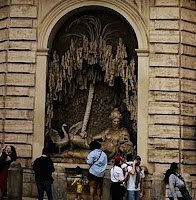Three things have lined up to increase our faith and testimony of God's prophecies and promises:
1. A study of the teaching of Isaiah as part of our Book of Mormon study where we are learning how the Lord always guides, warns and loves His Covenant children.
2. Daily time in the temple, the House of the Lord, where covenants are made, families are united for eternity, where all things center on Jesus Christ and where He is gathering His Covenant children.
3. And a visit to the Jewish Quarter in Rome for an up close look at the life, times and trials of a group of His Covenant children. Let us tell you about it and perhaps your understanding will increase like ours did!!
The Great Synagogue ...
...sits on the corner of Via del Tempio and is the heart of the community! On the exterior we could see tablets of the Ten Commandments, several menorah, large wooden doors, and grand columns. We found the square cupola on top interesting. It distinguishes it from the round cupolas found on the Catholic and Christian churches in Rome. This large synagogue replaced five smaller ones that were demolished in the mid-1800.
By appointment we were able to take a guided tour of the interior of the Synagogue which is beautiful! It was obvious right away that it is a well love, and well used place of worship. The women of the congregation are seated in the balconies just below the colorful glass windows.
The men are seated on the main floor on original wooden benches each with a name plaque and locked compartments that hold their prayer books and other essential items for worship.
The high ceiling is designed in rainbow colors as a reminder of the covenant God made in Noah's time, that the earth would never again be destroyed by flood. Blue areas on the ceiling are decorated with hundreds of stars as a reminder of God's promise that Abraham's posterity would be as numerous as the stars in the sky. The walls are painted with images of the Cedars of Lebanon which is a biblical reference to having strong roots, as well as other symbolism.
The central focus of the synagogue is the Aron Kodesh which shelters the Hebrew Torah or scrolls of scripture. They are solemnly removed three times a week and a portion is read aloud.
The Hebrew Museum
The museum was fascinating!!! We spent over an hour getting a real education on the traditions, culture and practices of Jewish history, customs, challenges, and faith. Particularly interesting was the way that they treasure their scrolls of scripture called the Torah.
The box holds numbered silver discs that are distributed among the men of the congregation and determine who does the reading from the Torah which is the heart of the synagogue. It is a parchment of perfectly handwritten columns of the first five books of Moses (Genesis, Exodus, Leviticus, Numbers and Deuteronomy in the Christian Bible). Because human hands can never touch the paper of the scrolls, the pencil-type implements shown here are used to keep the reader's place.
The large (3 feet tall) scrolls are protected in special handmade wrappings and fabric coverings called mappah.
The Torah/scrolls are housed in an ark called Aron Kodesh. They are wrapped in silk and adorned with a silver crown and rimmonim on the wooden handles of the scroll.
The Torah is treated with great honor and respect.
Museo dei Shoah -The Museum of the Catastrophe
Located near the Synagogue, is a building that houses a museum that aims to keep alive the memory of the extermination of 6 million Jews including Italian Jews.
In 1943 the Nazis occupied Rome and set in motion the deportation of the Jewish population who were already confined to living in the Ghetto.
On October 1943, over 1,000 men, women and children were taken from Rome and sent to Auschwitz. Just 16 survived. Walking through the Jewish Ghetto, if you are paying attention, you notice bronze plaques inlaid among the cobblestones
. We stopped to read the ones in front of this doorway.... ..."Here lived Anita Sermoneta. Born 1910. Arrested October 16, 1943 deported to Auschwitze. Died. In an unknown place. On an unknown date." A Very Brief Review of the Very LOOOOONG History of the Roman Jews
200 BC - Left Holy Land, settled in Rome, before the "scattering".
500 AD - With the fall of the Roman Empire, their previous favored status fluctuated as Christianity enveloped Rome. For the most part they prospered but could not intermarry, proselyte or build new synagogues.
1492 - Rome's Jews population doubles as Spain and other European countries expelled them.
1555 - The pope confined all Roman Jews into the 7-acres of mucky land along the Tiber River. They lived in cramped conditions, behind a wall, with a curfew for three centuries.
1870 - With Italian unification and a new secular government, Italian Jews were granted full rights and the old Ghetto was demolished.
1920 - The rise of the facism brought many anti-Jewish laws.
1943 - World War II brought the Nazi occupation of Rome. Of the 13,000 ghetto dwellers, about 2,000 were sent to concentration camps. Only a handful came back.
1982 - After a special service to bless the children, PLO terrorist attacked with hand grenade and machine guns killing a 2-year-old and injury 37 others. Since that time security at Jewish institutions has been tight with armed guards at each entrance to the neighborhood.
2024 - There are around 15,000 Jews living in Rome today. The congregation is very large and active. They send their children to the community day school in the ghetto. The neighbor hood is charming and full of character with restaurants serving Roman-Jewish cuisine (artichokes are our favorite), Kosher bakery, and gelato shops. It is an amazing walk through time and a tribute to those who have created a new community amid the ruins of an old one.
A Map of the Jewish Quarter - Yesterday and Today
This interesting map gave us a real appreciation for how the area once was and how it has been rebuilt to the charming neighborhood it is today.
























































